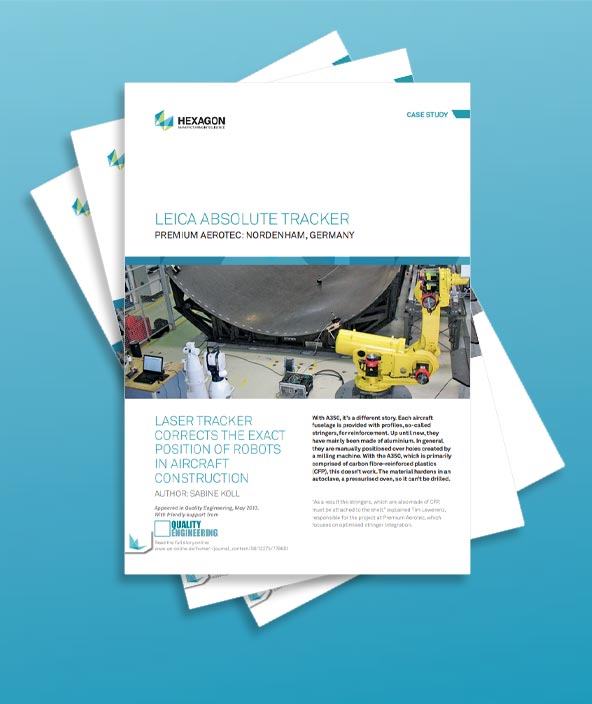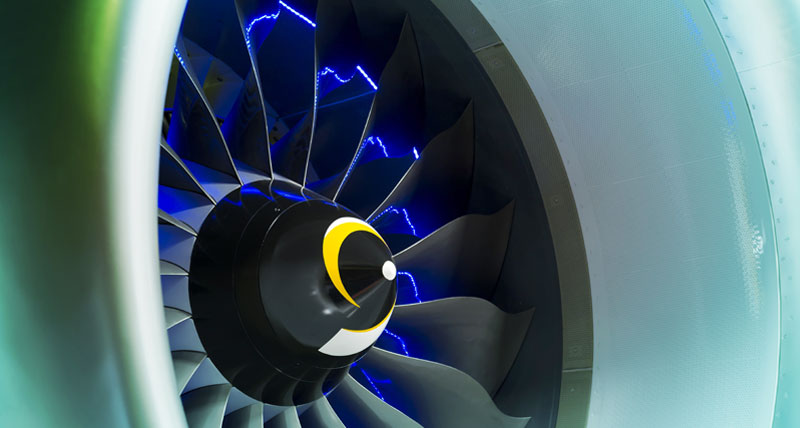Laser Tracker corrects the exact position of robots in aircraft construction
Premium Aerotec, Germany
Contact us
With A350, it’s a different story. Each aircraft fuselage is provided with profiles, so-called stringers, for reinforcement. Up until now, they have mainly been made of aluminium. In general, they are manually positioned over holes created by a milling machine. With the A350, which is primarily comprised of carbon fibre-reinforced plastics (CFP), this doesn’t work. The material hardens in an autoclave, a pressurised oven, so it can’t be drilled.
“As a result the stringers, which are also made of CFP, must be attached to the shell,” explained Tim Lewerenz, responsible for the project at Premium Aerotec, which focuses on optimised stringer integration. As an aerostructure supplier, the aircraft manufacturer supplies large parts for the new generation of Airbus’ longhaul aircraft, the maiden voyage of which is scheduled for the middle of this year. This includes the entire front fuselage. “The stringers have to be attached precisely to avoid subsequent drops in quality. Manual positioning is uneconomical here, as ultimately up to 13 aircraft of this type are to be built per month in the future. Our goal is to automate aircraft assembly with robots as well. The requirement, however, is that the robot works as precisely as a milling machine.”
As an aerostructure supplier, the aircraft manufacturer supplies large parts for the new generation of Airbus’ longhaul aircraft, the maiden voyage of which is scheduled for the middle of this year. This includes the entire front fuselage. “The stringers have to be attached precisely to avoid subsequent drops in quality. Manual positioning is uneconomical here, as ultimately up to 13 aircraft of this type are to be built per month in the future. Our goal is to automate aircraft assembly with robots as well. The requirement, however, is that the robot works as precisely as a milling machine.”
Put more specifically: to not jeopardise subsequent production and assembly processes, stringers for the A350 XWB (which can be up to 18 m long) must be set in place in the circumferential direction with a tolerance of +/- 0.3 mm and in the longitudinal direction with a tolerance of +/- 1 mm. After initial experiments, disillusionment spread in Nordenham. The first robot was supposed to move 3,000 mm, but stopped after 2,997 mm. The second always moved 1.5 mm too far. “A difference of 0.1 percent seems marginal at first, but with a stringer length of 18 m, it adds up. This was unacceptable to us,” said Lewerenz.
Robot manufacturer Fanuc wasn’t at fault, though, as the values were within the robots’ specifications. This means that robots work less precisely than milling machines, as they respond to changes in weight and force, which leads to deviations. The automotive industry gets around this by “teaching” the robots, but Lewerenz dismissed this possibility: “The system technology is designed for 800 aircraft in all. Sample components for teaching are thus not economically feasible. This is why we at Premium Aerotec have to assume that the machines are programmed fully offline so that everything is right during production.”
![]() So the aerospace industry supplier began searching for an option to move robots to the correct position without teaching them, that is, after taking corrective measures. A system was needed which could be placed on the robot head. With the Leica Absolute Tracker, a camera (the so‑called Leica T-Cam) and a Leica T-Mac the 3D coordinates of a point and its orientation in space (i, j, k or roll, pitch and yaw) can be captured simultaneously. This is important because 6D monitoring of the robot is required (it has six degrees of freedom). This means not only the position of the robot head can be monitored, but also its orientation.
So the aerospace industry supplier began searching for an option to move robots to the correct position without teaching them, that is, after taking corrective measures. A system was needed which could be placed on the robot head. With the Leica Absolute Tracker, a camera (the so‑called Leica T-Cam) and a Leica T-Mac the 3D coordinates of a point and its orientation in space (i, j, k or roll, pitch and yaw) can be captured simultaneously. This is important because 6D monitoring of the robot is required (it has six degrees of freedom). This means not only the position of the robot head can be monitored, but also its orientation.
If the three spatial orientations (roll, pitch and yaw) are required as in the application at hand, they are determined using the Leica T-Cam for the LED arrangement of a Leica T-Mac. The vario zoom enables nearly distance-independent precision of these photogrammetrically determined measurement values within the volume of work.
According to Lewerenz: “Another thing the laser tracker has going for it is that measurement results can be fed back, i.e. they can yield an accepted result. The degree to which this is important to us remains to be seen, as the components must still be measured and checked later. We also use the Leica Absolute Tracker for this purpose.” In the first production cell two robots, one mounted to the floor and the other mounted to a traversing axis and holding the tool head, take the two ends of a stringer and place it on the fuselage section.
As soon as the robot has positioned the stringer at one point, the measurement system switches on automatically. The robot informs it of its position, and the measurement system prompts the robot to make any corrections. In current trial runs, this takes about 20 seconds, but once the control circuit has been optimised, this will be reduced to just a few seconds. Following this, the connection is interrupted. The stringer is adhered in place and the tracker can correct the next robot head at the same time.
In any case, Lewerenz sees it as a great advantage that Premium Aerotec has on-site experience with the laser tracker. This means the method of operation, the system characteristics and their reliability are known and new systems do not absolutely need to be acquired if the existing laser tracker systems are available (and training costs don’t come into play either).
The test cell was intentionally designed openly with centralised software for any 3D measurement system in the series to achieve maximum flexibility. The external measurement system overrides the internal measurement systems of the robots here, according to Lewerenz. “What’s important to us is the separation of machine and measuring system. In our opinion, this concept has great future potential, since we are able to combine such an optimal measurement system with an optimum machine.”
![]() “This also appeals to us because we are ultimately able to do without an expensive specialised machine, and this extends beyond the positioning of the stringers,” related the project manager. Because at Premium Aerotec an ever more important priority is to reduce cycle times in production and assembly. Today, lots of manual work and permanent jigs, such as gantries, are required for this. The problem here is that they make flexible assembly difficult, i.e. the assembly of different products on a single line. “In addition, products change over the course of their life cycle, and we have to be able to respond flexibly to this.”
“This also appeals to us because we are ultimately able to do without an expensive specialised machine, and this extends beyond the positioning of the stringers,” related the project manager. Because at Premium Aerotec an ever more important priority is to reduce cycle times in production and assembly. Today, lots of manual work and permanent jigs, such as gantries, are required for this. The problem here is that they make flexible assembly difficult, i.e. the assembly of different products on a single line. “In addition, products change over the course of their life cycle, and we have to be able to respond flexibly to this.”
Very seldom are two aircraft exactly alike. Even if it’s just a toilet that’s positioned in a different place, the aerostructure needs to be adapted accordingly. This is essentially why each shell looks different,” explained Lewerenz.
He sees robots and mobile measurement systems as the future. They could herald a paradigm shift in mechanical engineering. This is why he hopes the project partners, including system supplier FFT-Edag, will develop and offer a turnkey solution. “We want to buy a finished product that works. And if something should go wrong at some point, there’s only one contact partner we need to get in touch with,” said Lewerenz.
He also had a request for Hexagon Manufacturing Intelligence. The Leica Absolute Tracker operates internally at 3,000 Hz and outputs 1,000 measurement values per second. However, these 1,000 data sets were output at a maximum rate of 10 Hz. “We need 100 Hz, because the robots operate internally at around 100 Hz and we want to be able to correct every single calculation cycle of the robot. This is why the new real-time interface (Ethercat), which enables data output at 1,000 Hz, is an important step in the right direction.”
The production concept: Six or eight robots are to be used, depending on the aircraft size, and the stringer is held by three or four robots on each side. Two rows of robots and two trackers work independently of one another.
Premium Aerotech Germany case study
Download

